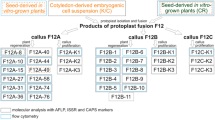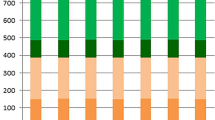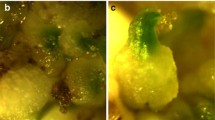Abstract
Pyrethrum (Tanacetum cinerariifolium (Trevir.) Schultz-Bip.) produces environmentally benign pesticides, the pyrethrins, and tansy (Tanacetum vulgare L.) lower terpenes of variable biological effectiveness. As an approach to improve the oil content and composition of tansy for enhanced biological activity, a somatic hybridization technique between tansy and pyrethrum was established. About 1×106 of leaf-mesophyll protoplasts of both species were mixed and fused with a solution containing 15% polyethylene glycol. Light-green and yellowish calli developed from the fusion experiments. The fusion-derived calli grew vigorously on MS medium supplemented with 6.4 mg l-1 of BAP, 0.8 mg l-1 of NAA, and 30–40 g l-1 of glucose. Nuclear DNA content, RAPD patterns, and volatile compounds were analyzed to determine the hybridity of the calli. The nuclear DNA content of the tansy and pyrethrum genotypes, and the protoplast-derived calli of tansy were 6.41, 7.39, 13.84, and 8.11 pg, respectively. The nuclear DNA content of individual calli derived from the protoplast fusion between tansy +tansy ranged from 8.84 (F43A) to 19.59 pg (F43C) while those of the tansy+pyrethrum fusions were 10.66 (F46A) and 31.87 pg (F46B). Using four 10-mer primers a total of 56 RAPD-PCR fragments were produced. The distance matrices of fragments were calculated by average linkage cluster analysis. Two visually separated clusters were observed. One cluster consisted of the two tansy genotypes and the fusion-derived callus F43A; the other consisted of pyrethrum and fusion-derived calli F46B and F46C. Volatile compounds, such as decadienal, artedouglasia oxide, heptadecane, syringaldehyde and coniferyl alcohol, analyzed by gas chromatography mass spectrometry, were found only in the protoplast fusion-derived calli F43A and F46B. Several less volatile compounds were also detected only in fusion calli. Hexadecanoic and linoleic acids were common to fusion-derived calli and tansy, and one unknown compound to fusion-derived calli and pyrethrum. Pyrethrins I and II were detected from pyrethrum, but not from the fusion-derived calli. The additive nuclear DNA content of protoplast fusion-derived calli and the results of the RAPDs suggest that interspecific fusions had occurred. The small number of volatile compounds detected from both the fusion calli and from the donor species indicates that the unorganized callus tissue is unable to produce tissue-specific volatile compounds.
Similar content being viewed by others
Author information
Authors and Affiliations
Additional information
Received: 4 August 1998 / Accepted: 30 September 1998
Rights and permissions
About this article
Cite this article
Keskitalo, M., Angers, P., Earle, E. et al. Chemical and genetic characterization of calli derived from somatic hybridization between tansy (Tanacetum vulgare L.) and pyrethrum (Tanacetum cinerariifolium (Trevir.) Schultz-Bip.). Theor Appl Genet 98, 1335–1343 (1999). https://doi.org/10.1007/s001220051200
Issue Date:
DOI: https://doi.org/10.1007/s001220051200




